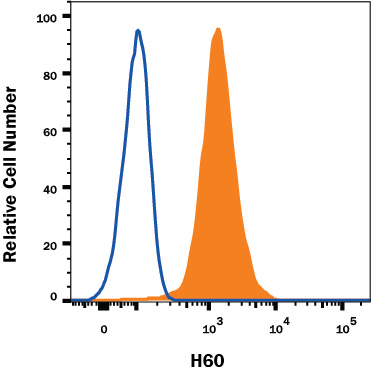Mouse H60 PE-conjugated Antibody Summary
Asp30-Gln212
Accession # Q3TDZ7
Applications
Please Note: Optimal dilutions should be determined by each laboratory for each application. General Protocols are available in the Technical Information section on our website.
Scientific Data
 View Larger
View Larger
Detection of H60 in RAW 264.7 Mouse Cell Line by Flow Cytometry. RAW 264.7 mouse monocyte/macrophage cell line was stained with Rat Anti-Mouse H60 PE-conjugated Monoclonal Antibody (Catalog # FAB1155P, filled histogram) or isotype control antibody (Catalog # IC006P, open histogram). View our protocol for Staining Membrane-associated Proteins.
Reconstitution Calculator
Preparation and Storage
- 12 months from date of receipt, 2 to 8 °C as supplied.
Background: H60
H60 was originally described as an immunodominant histocompatibility antigen that is expressed in BALB mice but not in B6 mice. More recently it was reported to function as a ligand for mouse NKG2D, an activating receptor found on NK cells, on some T cell subsets, and on stimulated macrophages. H60 shares approximately 25 percent amino acid identity with the Rae-1 family, a small group of proteins that also function as ligands for mouse NKG2D. H60 and the Rae-1 proteins are distantly related to MHC class I proteins, but they possesses only the alpha 1 and alpha 2 Ig-like domains, and have no capacity to bind peptide or interact with beta 2-microglobulin. The genes encoding these proteins are not found within the Major Histocompatibility Complex on mouse chromosome 17, but rather map to mouse chromosome 10. Unlike the GPI-linked Rae-1 proteins, H60 appears to be anchored to the membrane via a hydrophobic transmembrane segment. H60 transcripts were found in embryonic tissue, in spleen, and in some transformed cell lines. Transcripts were also observed in mouse skin cells after exposure to carcinogens. Binding of H60 to NKG2D results in the activation of cytolytic activity and/or cytokine production by the NKG2D-expressing effector cells. Ectopic expression of H60 on mouse tumor cell lines resulted in the in vivo rejection of the tumors (1-6).
- Malarkannan, S. et al. (1998) J. Immunol. 161:3501.
- Diefenbach, A. et al. (2000) Nature Immunol. 1:119.
- Cerwenka, A. et al. (2000) Immunity 12:721.
- Cerwenka, A. et al. (2001) Proc. Natl. Acad. Sci. USA 98:11521.
- Diefenbach, A. et al. (2001) Nature 413:165.
- NKG2D and its Ligands, www.RnDSystems.com.
Product Datasheets
Citations for Mouse H60 PE-conjugated Antibody
R&D Systems personnel manually curate a database that contains references using R&D Systems products. The data collected includes not only links to publications in PubMed, but also provides information about sample types, species, and experimental conditions.
6
Citations: Showing 1 - 6
Filter your results:
Filter by:
-
Immunotherapy of Dual-Function Vector with Both Immunostimulatory and B-Cell Lymphoma 2 (Bcl-2)-Silencing Effects on Gastric Carcinoma
Authors: L Ma, M Han, Z Keyoumu, H Wang, S Keyoumu
Med. Sci. Monit., 2017-04-25;23(0):1980-1991.
Species: Mouse
Sample Types: Whole Cells
Applications: Flow Cytometry -
Neural stem cells sustain natural killer cells that dictate recovery from brain inflammation.
Authors: Liu Q, Sanai N, Jin W, La Cava A, Van Kaer L, Shi F
Nat Neurosci, 2016-01-11;19(2):243-52.
Species: Mouse
Sample Types: Whole Cells
Applications: Flow Cytometry -
In vivo eradication of MLL/ENL leukemia cells by NK cells in the absence of adaptive immunity.
Authors: Nakata J, Nakano K, Okumura A, Mizutani Y, Kinoshita H, Iwai M, Hasegawa K, Morimoto S, Fujiki F, Tatsumi N, Nakajima H, Nakae Y, Nishida S, Tsuboi A, Oji Y, Oka Y, Sugiyama H, Kumanogoh A, Hosen N
Leukemia, 2013-11-13;28(6):1316-25.
Species: Mouse
Sample Types: Whole Cells
Applications: Flow Cytometry -
Targeting Stat3 induces senescence in tumor cells and elicits prophylactic and therapeutic immune responses against breast cancer growth mediated by NK cells and CD4+ T cells.
J. Immunol., 2012-06-29;189(3):1162-72.
Species: Mouse
Sample Types: Whole Cells
Applications: Flow Cytometry -
Small intestinal intraepithelial lymphocytes expressing CD8 and T cell receptor gammadelta are involved in bacterial clearance during Salmonella enterica serovar Typhimurium infection.
Authors: Li Z, Zhang C, Zhou Z, Zhang J, Zhang J, Tian Z
Infect. Immun., 2011-12-05;80(2):565-74.
Species: Mouse
Sample Types: Whole Cells
Applications: Flow Cytometry -
NKG2D receptor signaling enhances cytolytic activity by virus-specific CD8+ T cells: evidence for a protective role in virus-induced encephalitis.
Authors: Walsh KB, Lanier LL, Lane TE
J. Virol., 2007-12-26;82(6):3031-44.
Species: Mouse
Sample Types: Whole Cells
Applications: Flow Cytometry
FAQs
No product specific FAQs exist for this product, however you may
View all Antibody FAQsReviews for Mouse H60 PE-conjugated Antibody
There are currently no reviews for this product. Be the first to review Mouse H60 PE-conjugated Antibody and earn rewards!
Have you used Mouse H60 PE-conjugated Antibody?
Submit a review and receive an Amazon gift card.
$25/€18/£15/$25CAN/¥75 Yuan/¥2500 Yen for a review with an image
$10/€7/£6/$10 CAD/¥70 Yuan/¥1110 Yen for a review without an image

